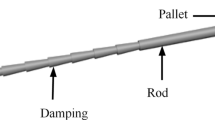Abstract
In order to study the mechanical mechanism of the new tension–compression composite anchor, the finite element software is used to establish the numerical calculation model of the new composite anchor, and the numerical drawing test is carried out. Through numerical experiments, the optimal position range of the bolt bearing plate is obtained, and the axial load and shear stress distribution of the bolt were analyzed. The results show that the ultimate pullout force of the new tension–compression composite bolt increases first and then decreases with the movement of the bearing plate position, and the optimal position is at the position where the length ratio of the tension–compression anchorage section is 3:4. At the same time, the study shows that the optimal position of the bearing plate has an optimal position interval. The ultimate uplift capacity of the new tension–compression composite anchor is 118.6% and 94% higher than that of the traditional tension anchor and pressure anchor, respectively. The shear stress distribution of the new tension–compression composite anchor is more uniform. The peak shear stress first appears at the bearing plate and begins to transfer to both sides of the bearing plate with the increase in the drawing force, which increases first and then decreases. Since the new tension–compression composite anchorage section is in an unbonded state, the axial load of the bolt is always equal to the drawing force. The axial force distribution of the tensile anchorage section is similar to that of the traditional tensile bolt and decreases exponentially along the axial direction of the bolt. Under the action of ultimate drawing force, the plastic zone distribution of the new tension–compression composite anchor is different from that of the traditional tension anchor and the traditional pressure anchor. The plastic zone first appears in the position of the bearing plate and begins to transfer to both sides of the bearing plate with the increase in the drawing force. When the plastic strain exceeds the allowable strain of the interface, the bolt pulls out from the anchor hole and the bolt support structure fails.









Similar content being viewed by others
References
Che N, Wang H, Jiang M, Liao Y (2018) Mechanism investigation of rock bolt failure in anchorage segment under Pullout via DEM. Chin J Undergr Space Eng 14(S2):716–724
Chen J, Chen X (2019) Analysis of whole process of bolt pulling based on wavelet function. Rock Soil Mech 40(12):4590–4596
Li P, Huang J, Wang F (2021) Progressive failure process and influencing factors of bolts under the loading of pullout. J Beijing Univ Technol 47(04):346–356
Liu Q, Lei G, Peng XL (2017) Experimental study and mechanism analysis of influence of bolt anchoring on shear properties of jointed rock mass. Rock Soil Mech 38(S1):27–35
Li C, Wu H, Wang B (2018) Experimental analysis of anchorage performance and interfacial mechanics transfer characteristic of tension-type anchor rods. Ind Construct 48(09):123–127
Liu W, Dong T (2020) Limit distance and the estimating efficiency factor of rock group anchor. Chin J Undergr Space Eng 16(01):194–200
Ma S, Zhao Z, Nie W (2016) A numerical model of fully grouted bolts considering the tri-linear shear bond-slip model. Tunnel Undergr Space Technol 54:73–80
Tu B, Liu S, Yu J (2018) Analysis of anchorage performance on new tension-compression anchor I: simplified theory. Chin J Geotech Eng 40(12):2289–2295
Tu B, Yu J, He J (2019a) Analysis of anchorage performance on new tension-compression anchor II: model test. Chin J Geotech Eng 41(03):475–483
Tu B, Cai Y, He J (2019b) Analysis of anchorage performance on new tension-compression anchor III: field test. Chin J Geotech Eng 41(05):846–854
Zhang B, Zhang Z, Wang B (2016) Experimental study of application of yielding bolt to large deformation tunnel. Rock Soil Mech 37(07):2047–2055
Zhao Z (2019) Analytical solution of shear stress in anchorage section of tension bolt. Theor Res Urban Construct 35:58–64
Zhou H, Xiao M, Chen J (2016) Study of anchoring mechanism and analysis of anchoring effect of fully grouted rock anchor in large-scale underground caverns. Rock Soil Mech 37(05):1503–1511
Zhu C, He M, Zhang X (2021) Nonlinear mechanical model of constant resistance and large deformation bolt and influence parameters analysis of constant resistance behavior. Rock Soil Mech 42(07):1911–1924
Zhu X, Chen Z, Ren Y (2019) Numerical simulation study on the anchorage mechanism of yield supporting in deep tunnel. Geotech Geol Eng 37:2091–2102
Acknowledgements
This work was supported by State Key Laboratory for Geomechanics and Deep Underground Engineering, China University of Mining & Technology/China University of Mining & Technology, Beijing(SKLGDUEK1926) and Liaoning Provincial Natural Fund Guidance Plan (2019-ZD-0571) and Science and Technology Project of Jingpo New Area (JinPu-0103009) and Liaoning Key Research and Development Plan Guidance Project (LiaoNing-2017229007) and Liao Ning Revitalization Talents Program (XLYC 1807219) and Scientific Research, Innovation and Entrepreneurship Team of Dalian University (XQN202002).
Author information
Authors and Affiliations
Corresponding author
Additional information
Publisher's Note
Springer Nature remains neutral with regard to jurisdictional claims in published maps and institutional affiliations.
Rights and permissions
About this article
Cite this article
Yang, S., Zhu, X., Zhang, G. et al. Research on the Mechanics Performance of the New Tension–Compression Rock Bolt Through Numerical Simulation. Geotech Geol Eng 40, 2255–2266 (2022). https://doi.org/10.1007/s10706-021-02024-2
Received:
Accepted:
Published:
Issue Date:
DOI: https://doi.org/10.1007/s10706-021-02024-2




